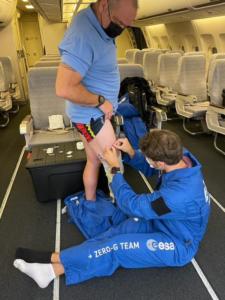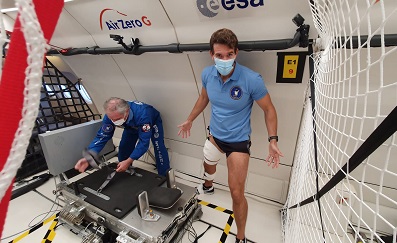Cometa EMG goes weightless in HIFIm parabolic flight campaign
EMG
We were thrilled to hear from St Mary’s University recently, whose research group took part in a parabolic flight campaign to test HIFIm in microgravity for future space exploration.
A new invention
Astronauts can lose as much as 10% of bone density during six months in space, according to NASA, because there’s no gravity for their body to push against.
To offset the effect, they exercise for two hours a day, at least six days a week. But a machine invented by John Kennett could reduce those gruelling workouts to just six minutes a day, by enabling astronauts to jump in zero gravity. [Read more on Sky News.]
What is HIFIm?
HIFIm (High Frequency Impulse for Microgravity) is a sled-based exercise system comprised of upper and lower moving carriages that are mechanically connected via a rack and pinion such that the movement of the carriages is constrained to be equal and opposite. The HIFIm system can be used to perform many resistance-type exercises as the movement of the carriages is resisted by high tensile springs. One of these exercises is jumping. The user, borne by the upper carriage, pushes off the platform on the lower carriage causing the carriages to move apart in an equal and opposite direction, with the resistance provided by the springs pulling the carriages back together. This countermass system reduces resultant forces to levels within the capabilities of standard aircraft vibration isolation systems i.e the force created by jumping is contained and not transferred to the surrounding structures.
This is of particular interest for astronauts training in microgravity. Jumping has been shown to be an effective exercise modality for reducing the negative physiological effects of microgravity, such as bone mineral density loss and muscle atrophy. Currently, no exercise system allows jumping or any reactive type exercise due to poor vibration isolation and potential damage to the spacecraft. Because of this, HIFIm is a very attractive and viable exercise countermeasure for astronauts to be used for future space exploration.
Testing in microgravity
The recent parabolic flight campaign tested HIFIm in microgravity. This was the first time repetitive jumping was achieved in microgravity; a world first. During the jumping trials, data was collected to investigate the mechanical performance of HIFIm and biomechanical data from the jumper. This included electromyography data using the Cometa EMG system.
The team hopes to use these data to further understand muscle activation strategies while jumping in microgravity.

Find out more
To keep up to date with the HIFIm project, you can follow them on Instagram for the latest pictures and videos.
John Kennett recently presented the HIFIm project to BASES2021, which you can view below.

